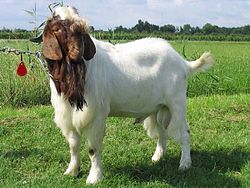Boer goat
A Boer goat buck
Contents
Origins and characteristics
The Boer goat was probably bred from the indigenous South African goats of the Namaqua, San, and Fooku tribes, with some crossing of Indian and European bloodlines being possible. They were selected for meat rather than milk production; due to selective breeding and improvement, the Boer goat has a fast growth rate and excellent carcass qualities, making it one of the most popular breeds of meat goat in the world. Boer goats have a high resistance to disease and adapt well to hot, dry semideserts. United States production is centered in west-central Texas, particularly in and around San Angelo and Menard. The original US breeding stock came from herds located in New Zealand. Only later were they imported directly from South Africa.Boer goats commonly have white bodies and distinctive brown heads. Some Boer goats can be completely brown or white or paint, which means large spots of a different color are on their bodies. Like the Nubian goat, they possess long, pendulous ears. They are noted for being docile, fast-growing, and having high fertility rates. Does are reported to have superior mothering skills as compared to other breeds. Boer goats tend to gain weight at about the same rate as their sire, so a buck from a proven fast-growing bloodline will command the highest price, as its offspring will tend to also be fast growers. The primary market for slaughter goats is a 22–36 kg (49–79 lb) kid; kids should reach marketable size at weaning age. The kid of a proven fast-growing sire might weigh 36 kg (79 lb) at 90 days, while the kid of a poor-quality sire might weigh only 15 kg (33 lb) at 90 days. An average-quality buck will initially be less expensive to purchase, but it can significantly undermine an operation's long-term profitability.
Doe
A doe used to breed show-quality goats are normally very large, as nonshow goats are unexpected to be of large stature. For commercial meat production, medium-sized does are normally preferred, as they produce the same number of kids, but require less feed to do so. As a general rule, the more kids born per doe, the greater profit margins for the owner. Boer goats are polyestrous (they can breed throughout the year), and they reach sexual maturity at five months of age. A typical breeding program is to produce three kid crops every two years, meaning the does are pregnant for five months, nurse their kids for three months, and then are rebred. Multiple births are common, and a 200% kid crop is achievable in managed herds. Usually, first-time does have one kid, but they may have more. After that, they usually have two kids every other breeding. The kids can be brown, black, white, or mixed.Crossbreeding
A 7/8 (F3) Boer goat, paint doe
Percentage Boer goats are very common in commercial meat herds, and with those just starting out in the Boer goat business due to ease of acquisition and affordability. Over time, percentage animals can be bred up to American purebred status. An American purebred is a Boer goat of 15/16ths Boer blood (F4) for does and 31/32nds blood (F5) for Boer bucks. Bucks must be one generation of Boer breeding higher than does to achieve this status because they have the potential to spread their genetic pool much further than any single doe; a higher level of Boer blood lessens the chances of other breed qualities in the offspring. Although American purebreds can never be registered as Fullblood (FB), many breeders still use a good American purebred buck with excellent results.
Many producers still prefer purebred or fullblood bucks and does, and intentional crossbreeding is far from universal.
Note: The 'F' designation is the commonly used shorthand for indicating the percentage of pure blood (Boer in this case) resulting from crossbreeding of a Pureblood boer buck with does of other breeds:
- F1 : 1/2 boer blood (Pureblood buck sire, other breed doe)
- F2 : 3/4 boer blood (Pureblood buck sire, F1 doe)
- F3 : 7/8 boer blood (Pureblood buck sire, F2 doe)
- F4 : 15/16 boer blood (Pureblood buck sire, F3 doe)
- F5 : 31/32 boer blood (Pureblood buck sire, F4 doe)









No comments:
Post a Comment